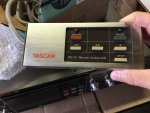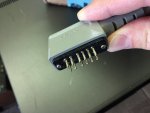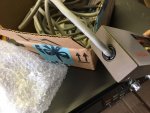sweetbeats
Reel deep thoughts...
So I've had an Onkyo TA-2058 consumer cassette deck for over three decades...its been dormant for awhile, and, upon pulling it out recently to play some archived cassettes I discovered the capstan belt was dried out, stretched and slipping. I found a rubber band that worked to get through what I needed to do, and also ordered a set of new belts, but getting the old Onkyo out reminded me I've always lusted a bit after a Tascam 122...it sounds a bit silly but one of the main attractions for me was simply having a cassette deck that is rack-mountable. And then I liked the idea of some of the calibration trimmers being front-panel accessible. But most of what I saw available was the mkII machines, and the prices were always a bit rich for me and anymore they are just silly, plus it was just never enough of a priority since I rarely used a consumer format cassette deck for anything anymore. I guess the other ideation I had is that the Tascam would be easier to work on than the Onkyo. The Onkyo is a great three-head machine, but the construction is consumer which means the guts aren't well laid out for servicing...but its a good machine...I mean, it still works like a champ after all these years and only the capstan belt needs replaced. ANYway...
The past few weeks the Tascam 122 bug has been itching at me and I've been trolling auction sites and reading the manuals of the different generations of 122 machines...and I found myself drawn to the old-school first generation 122. My understanding is the mkII and mkIII have a better R/P head in them than the 1st generation, but they also have the direct-drive capstan vs. the belt-drive version, and the direct drive assembly is the same one that causes trouble in the 238 with the "jet-engine" runaway speed thing and its a potentially expensive fix if you can find a replacement servo board assembly...anyway...I had a 234 at one point and old-school was good with me...less complicated circuitry and fewer bells and whistles in trade for maybe better end-user serviceability. But as I studied the schematics I was kind of taken aback the original 122 has only one opamp in the entire stereo signal path...there are ICs for the Dolby B and HXPro processors of course, but almost all of the line amplification in the 1st gen 122 is discrete transistor-based, with an integrated transistor array at the output stage...relatively few coupling caps in the audio path...the power supply is even discrete...quite old-school...I started watching this one on eBay that appeared very clean, and clearly needed a capstan belt...I'm getting pretty good at repairing the cassette multitrack machines and so that didn't bother me. The price was right...should be able to recoup my purchase and parts expenses by selling the Onkyo...and I thought it was cool the 122 runs at 1 7/8ips ad 3 3/4ips...not that I would have a need to do cassette masters at 3 3/4ips, but...its cool...and the multiple line inputs, switchable sidechain for a dbx n/r unit...and its a nice looking machine. So I pulled the trigger.
Its missing one of the little switch knobs on the right...that's going to be hard to find...and a couple of the switch levers got tweaked at some point, but I can straighten those...I've verified the motors are in great shape, the capstan belt has melted, and it needs a new pinch roller (already reached out to Terry Witt and he says he can re-rubber the 122 pinch roller because it is on a metal core instead of plastic). The belts are readily available. It needs a new meter lamp for one of the VU meters but that is easy-peasy and I already have a stock of those leaded axial lamps. So I'm happy. But it got even better when I opened it up. More on that below. First some pics.
Here is the face...there are a couple scratches through the finish on the face, but they are minor...it looks good as-is and will easily clean up even better. This was a well cared for machine:
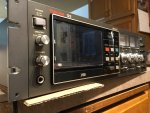

And here is the back...dbx I/O jumpers intact...again, clean and straight:
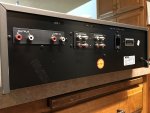
But then when I opened it up I was greeted by a roomy chassis with easy-access boards, and thoughtful component layout...big main transformer...
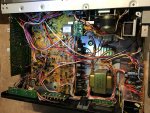
...and then when I looked at the capstan belt issue I was surprised...this thing has the largest diameter flywheel I have ever seen in a cassette machine...the spooling motor is the gold motor in the center...if you look just to the left you can see the top of the capstan flywheel you can see the top of the flywheel with melted belt on it...you can maybe judge the size of it by the curvature of what you can see...its maybe 3" in diameter? And look to the left of the spooling motor...those rectangular blocks...those are solenoids...the same solenoids Teac used for brakes, pinch roller and lifter actuation in many of the their open-reel tape machines...Teac used them in the 1st gen 122 for head assembly lifting, pinch roller actuation and spooling functions instead of plastic cam gears and a control motor...its relatively beefy...and makes nice positive *tchuk* noises. Me likey:
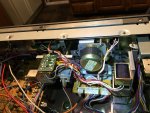
I captured a short video snippet of the solenoids in action:
YouTube
And this is a small thing but the left and right input level controls are coupled by a gear-driven mechanism to maintain stereo tracking...you can move them independently too, but if you want to have them track you just turn one and it smoothly drives the other...captured a short video of this too:
YouTube
Anyway, I really like my early generation 122...can't wait to get it fixed up and take it for a spin...but first have to get the Onkyo all ship-shape and find a new home for it.
Hey if anybody happens to have or know a source for the small black switch knob I'm missing could you PM me?
[EDIT]
I forgot to mention, because the 1st gen 122 was made in what I consider to be something of a more golden age for Teac/Tascam, the manual is *excellent*...comprehensive theory of operation section along with the typical sections...well written...attention to detail...a few years later this was not the case.
Oh and who could resist getting a free copy of Chicago's Greatest Hits Volume II with their 122??

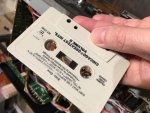
The past few weeks the Tascam 122 bug has been itching at me and I've been trolling auction sites and reading the manuals of the different generations of 122 machines...and I found myself drawn to the old-school first generation 122. My understanding is the mkII and mkIII have a better R/P head in them than the 1st generation, but they also have the direct-drive capstan vs. the belt-drive version, and the direct drive assembly is the same one that causes trouble in the 238 with the "jet-engine" runaway speed thing and its a potentially expensive fix if you can find a replacement servo board assembly...anyway...I had a 234 at one point and old-school was good with me...less complicated circuitry and fewer bells and whistles in trade for maybe better end-user serviceability. But as I studied the schematics I was kind of taken aback the original 122 has only one opamp in the entire stereo signal path...there are ICs for the Dolby B and HXPro processors of course, but almost all of the line amplification in the 1st gen 122 is discrete transistor-based, with an integrated transistor array at the output stage...relatively few coupling caps in the audio path...the power supply is even discrete...quite old-school...I started watching this one on eBay that appeared very clean, and clearly needed a capstan belt...I'm getting pretty good at repairing the cassette multitrack machines and so that didn't bother me. The price was right...should be able to recoup my purchase and parts expenses by selling the Onkyo...and I thought it was cool the 122 runs at 1 7/8ips ad 3 3/4ips...not that I would have a need to do cassette masters at 3 3/4ips, but...its cool...and the multiple line inputs, switchable sidechain for a dbx n/r unit...and its a nice looking machine. So I pulled the trigger.
Its missing one of the little switch knobs on the right...that's going to be hard to find...and a couple of the switch levers got tweaked at some point, but I can straighten those...I've verified the motors are in great shape, the capstan belt has melted, and it needs a new pinch roller (already reached out to Terry Witt and he says he can re-rubber the 122 pinch roller because it is on a metal core instead of plastic). The belts are readily available. It needs a new meter lamp for one of the VU meters but that is easy-peasy and I already have a stock of those leaded axial lamps. So I'm happy. But it got even better when I opened it up. More on that below. First some pics.
Here is the face...there are a couple scratches through the finish on the face, but they are minor...it looks good as-is and will easily clean up even better. This was a well cared for machine:


And here is the back...dbx I/O jumpers intact...again, clean and straight:

But then when I opened it up I was greeted by a roomy chassis with easy-access boards, and thoughtful component layout...big main transformer...

...and then when I looked at the capstan belt issue I was surprised...this thing has the largest diameter flywheel I have ever seen in a cassette machine...the spooling motor is the gold motor in the center...if you look just to the left you can see the top of the capstan flywheel you can see the top of the flywheel with melted belt on it...you can maybe judge the size of it by the curvature of what you can see...its maybe 3" in diameter? And look to the left of the spooling motor...those rectangular blocks...those are solenoids...the same solenoids Teac used for brakes, pinch roller and lifter actuation in many of the their open-reel tape machines...Teac used them in the 1st gen 122 for head assembly lifting, pinch roller actuation and spooling functions instead of plastic cam gears and a control motor...its relatively beefy...and makes nice positive *tchuk* noises. Me likey:

I captured a short video snippet of the solenoids in action:
YouTube
And this is a small thing but the left and right input level controls are coupled by a gear-driven mechanism to maintain stereo tracking...you can move them independently too, but if you want to have them track you just turn one and it smoothly drives the other...captured a short video of this too:
YouTube
Anyway, I really like my early generation 122...can't wait to get it fixed up and take it for a spin...but first have to get the Onkyo all ship-shape and find a new home for it.

Hey if anybody happens to have or know a source for the small black switch knob I'm missing could you PM me?
[EDIT]
I forgot to mention, because the 1st gen 122 was made in what I consider to be something of a more golden age for Teac/Tascam, the manual is *excellent*...comprehensive theory of operation section along with the typical sections...well written...attention to detail...a few years later this was not the case.
Oh and who could resist getting a free copy of Chicago's Greatest Hits Volume II with their 122??


Last edited:

